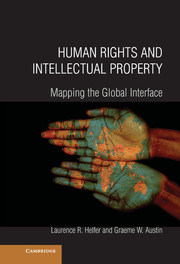Book contents
- Frontmatter
- Contents
- Preface
- 1 Mapping the Interface of Human Rights and Intellectual Property
- 2 The Human Right to Health, Access to Patented Medicines, and the Restructuring of Global Innovation Policy
- 3 Creators' Rights as Human Rights and the Human Right of Property
- 4 Rights to Freedom of Expression, to Cultural Participation, and to Benefit from Scientific Advancements
- 5 The Right to Education and Copyright in Learning Materials
- 6 The Human Right to Food, Plant Genetic Resources, and Intellectual Property
- 7 Indigenous Peoples' Rights and Intellectual Property
- 8 Conclusion
- References
- Acknowledgments
- Index
- Cases Discussed (Selected)
7 - Indigenous Peoples' Rights and Intellectual Property
Published online by Cambridge University Press: 05 June 2012
- Frontmatter
- Contents
- Preface
- 1 Mapping the Interface of Human Rights and Intellectual Property
- 2 The Human Right to Health, Access to Patented Medicines, and the Restructuring of Global Innovation Policy
- 3 Creators' Rights as Human Rights and the Human Right of Property
- 4 Rights to Freedom of Expression, to Cultural Participation, and to Benefit from Scientific Advancements
- 5 The Right to Education and Copyright in Learning Materials
- 6 The Human Right to Food, Plant Genetic Resources, and Intellectual Property
- 7 Indigenous Peoples' Rights and Intellectual Property
- 8 Conclusion
- References
- Acknowledgments
- Index
- Cases Discussed (Selected)
Summary
Introduction
During the past several decades, in a variety of international and domestic fora, indigenous peoples have asserted the right to recognition of and control over their culture and traditional knowledge in areas such as biodiversity, medicines, and agriculture. As we discuss in Chapter 1, the increased attention given to the rights of indigenous peoples by U.N. agencies in the 1990s was among the catalysts that encouraged international human rights bodies to address intellectual property issues. This topic has generated a significant amount of commentary and analysis and continues to be the focus of numerous initiatives by international agencies and national governments. It is but one of a large array of human rights issues concerning indigenous peoples that have arisen in recent years.
Indigenous peoples live in more than sixty nations, and studies have estimated their total number world wide as 300 million. They are among the most economically destitute members of the human family and have frequently experienced adverse treatment, including forced assimilation, destruction of their cultures, racism, and loss of lands and resources to colonizers, governments, and commercial entities. Indigenous peoples consider themselves to be “the historical successors of the peoples and nations that existed on their territories before the coming of the invaders of these territories, who eventually prevailed over them and imposed on them colonial or other forms of subjugation, and whose historical successors now form the predominant sectors of society.”
- Type
- Chapter
- Information
- Human Rights and Intellectual PropertyMapping the Global Interface, pp. 432 - 502Publisher: Cambridge University PressPrint publication year: 2011



